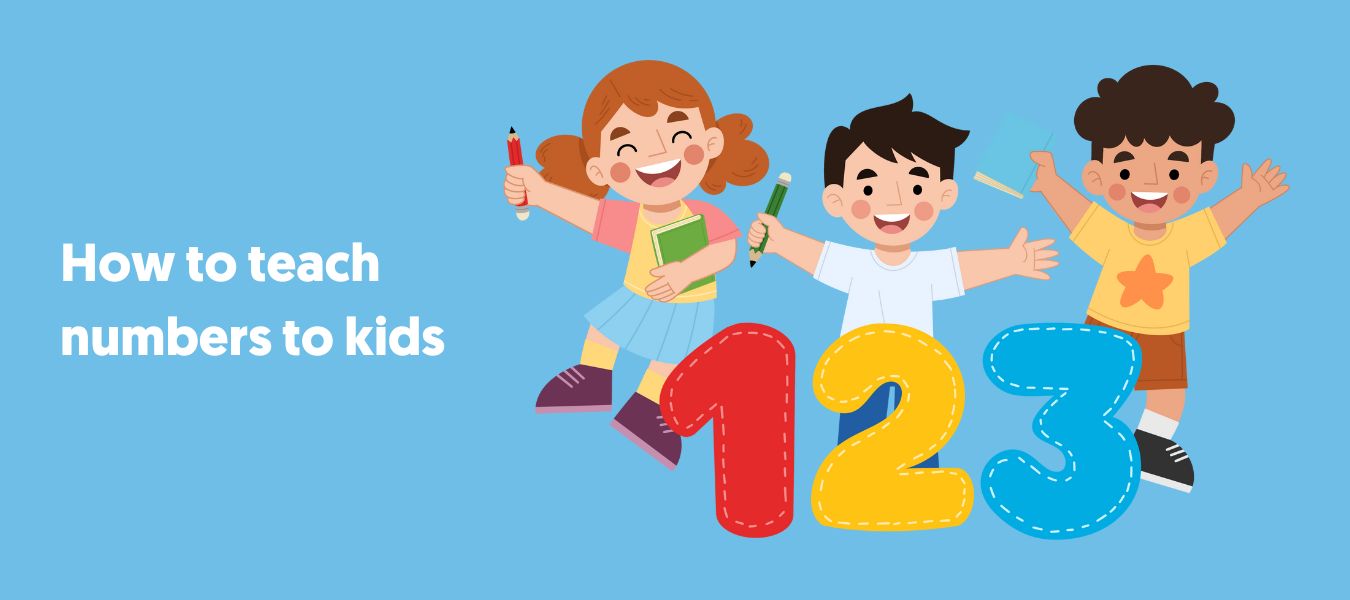How to Teach Numbers to Kids Effectively - Mastering the Basics

Remember the first time your child held up one tiny finger to indicate their age? That moment marks the beginning of a fascinating journey into the world of numbers. The world’s a giant classroom, and numbers are some of its most often seen components. As parents and educators, it's our privilege and responsibility to guide our little ones through this journey, making it as enjoyable, engaging and effective as possible. In this comprehensive guide, we'll explore various strategies and tips to teach numbers to kids, ensuring they grasp these fundamental concepts that will support their lifelong learning.
Learning numbers at an early age is critical for the intellectual development of children. At The HDFC Schools, we ensure this by focusing on holistic development, and this has helped us rank among the best schools in Gurugram, top schools in Bengaluru and also among the 10 best schools in Pune.
When to Start Teaching Numbers to Kids?
Between 18 months and 2 years old is typically the time to start teaching kids about numbers, since this is when children start enjoying number rhymes and books. Simple activities like counting fingers or objects help them grasp the concept of quantity. Around the age of 3, many children can count up to 10 and recognise numerals. However, every child is unique, and their readiness can vary. It's crucial to watch for signs of interest and not rush the process. By introducing numbers in a fun and engaging way, you're setting the stage for a smooth learning experience for your child.
Formal learning of numbers often begins in pre-kindergarten. At this stage, pre-schools introduce more structured activities that involve counting and recognising written numerals.
Strategies for Teaching Numbers to Kids
Incorporate Number Rhymes and Songs
Songs and rhymes like "10 Little Monkeys" and "One, Two, Buckle My Shoe" are not just fun; they're educational. These catchy tunes help children remember numbers and can be a delightful way to introduce the concept of counting.
Engage with Number Toys
Toys like puzzles and building blocks aren't just for play; they're powerful learning tools. By manipulating these objects, children can visually and physically understand what numbers represent, making abstract concepts more concrete and understandable.
Utilise Number Puzzles
Puzzles are a fantastic way to reinforce number recognition. They combine play with learning, making the process enjoyable and effective. Look for puzzles that are age-appropriate and gradually increase in complexity as your child's understanding grows.
Begin With the Number Formation
Initiate learning by teaching children the physical act of writing numbers. Begin with simple strokes and progress to more complex shapes; this enhances both visual and motor skills and is crucial for development of numerical skills.
Count Fingers and Toes
Never underestimate the power of your own hands (and feet)! Counting fingers and toes with your child is a personal and interactive way to teach them about numbers. It's a strategy that's always at hand, quite literally.
Incorporate Numbers into Daily Life
Numbers are all around us, from the clock on the wall to your computer’s keyboard, and the number plate of your vehicle. Point these out and discuss them with your child. This way, you're helping them understand the practical application and omnipresence of numbers.
Play Connect the Dots to Teach the Order of Numbers
Enhance understanding of numerical sequence through connecting the dots exercises. This hands-on approach allows children to visualise and internalise the order of numbers in a playful and interactive manner.
Use Flashcards
Use visual aids like flashcards to help in number recognition. Customise flashcards with vibrant images to capture a child’s attention, facilitating a quick and interactive learning experience.
Techniques and Tools to Teach Kids about Numbers
Read Number Books
Books are gateways to new worlds, including the world of numbers. Select books that are engaging and colourful, with stories and illustrations that bring numbers to life. For instance:
- "Chicka Chicka 1, 2, 3" by Bill Martin Jr. and Michael Sampson: This vibrant book brings numbers to life as they climb up an apple tree, providing a fun and rhythmic way to learn about numbers.
- "Ten Black Dots" by Donald Crews: This classic book uses simple dots to teach counting and encourages imagination by showing what can be created with just a few dots.
- "Anno's Counting Book" by Mitsumasa Anno: Without words, this book uses beautiful illustrations to explore counting, seasons, and the passage of time, offering a deeper understanding of numbers.
Incorporating these books into your teaching strategy can make learning numbers an exciting and imaginative adventure for your child.
Use Printables and Educational Resources
The internet is a treasure trove of resources. Look for printables and online games that make learning about numbers fun and interactive. These resources often offer a structured way to learn, which can be very effective.
Point Out Numbers in the Environment
Whether it's street signs or store prices, numbers are everywhere. Make a game out of spotting and discussing these numbers with your child. It's a fun and practical way to reinforce their learning.
Common Challenges and Solutions
It's normal for children to face challenges when learning numbers. Some might struggle with recognition, while others might find sequencing difficult. Be patient and try different strategies to see what works best for your child. Remember, the goal is to make learning enjoyable and stress-free.
Things To Keep in Mind While Teaching Numbers To Kids
Patience and Encouragement
Maintain a patient and encouraging approach, recognising that each child learns at their own pace. Positive reinforcement and praise for effort contribute to a healthy and enjoyable learning experience.
Real-Life Context
Relate numerical concepts to real-life situations. Incorporate numbers into everyday activities, such as counting items during grocery shopping or identifying numbers on street signs, to show the practical application of mathematical skills.
Multisensory Learning
Recognise and accommodate diverse learning styles by incorporating multisensory experiences. Use tactile materials, visual aids, and interactive games to engage different senses, promoting a more comprehensive understanding of numbers.
Repetition and Reinforcement
Emphasise the importance of repetition to reinforce learning. Regularly revisit previously covered concepts and provide opportunities for practice to solidify understanding and build confidence in working with numbers.
Individualised Instruction
Tailor your teaching approach to the individual needs and interests of each child. Observing and understanding their unique learning styles allows for a more personalised and effective educational experience.
Make Learning Fun
Infuse an element of fun into lessons to keep children engaged and interested. Utilise games, stories, and interactive activities to create an enjoyable learning environment, fostering a positive attitude towards numbers.
Conclusion: Counting on a Bright Future
Teaching numbers to kids is more than just a teaching task; it's an opportunity to bond and discover the world together. By using the strategies outlined in this guide, you're not just teaching numbers; you're laying the foundation for your child's future learning and success. So, take a deep breath, count to three, and embark on this exciting educational adventure together!
Further Reading
Once your child has mastered the basics of learning the small numbers, you can progress to something more challenging. You could teach them how to write small numbers in words, and then even progress to the bigger numbers as they are older. You can find some free resources for that below, and even more are linked to in the articles below:
